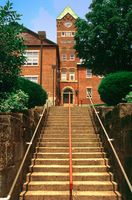 | Back to e-WV
| Back to e-WV
 The West Virginia Encyclopedia
The West Virginia Encyclopedia
 | Back to e-WV
| Back to e-WV
 The West Virginia Encyclopedia
The West Virginia Encyclopedia

Glenville State University, established in 1872, is located in Glenville. Originally founded as a teacher’s college, Glenville State also emphasizes business, human services, music, and natural resources management.
The college began as the Glenville Branch of the State Normal School and was established by an act of the legislature on February 19, 1872. Local citizens Milton Norris and Nelson M. Bennett were leaders in acquiring an original tract of three acres with a two-story frame dwelling. This property was donated to the state and ready for use in the fall of 1873.
The first session of the college opened on January 14, 1873, in the old Gilmer County courthouse, with the colorful T. Marcellus Marshall as acting principal. Three months later, Louis Bennett of Weston was appointed principal. Bennett was later a candidate for governor and the father of World War I aviator Louis Bennett Jr. After two years he resigned, and Marshall was again chosen principal. In that capacity Marshall gave five years of devoted service.
Although the primary purpose in establishing Glenville Normal was to educate teachers, preparatory courses were also authorized to prepare students for college work. As high schools became more numerous, preparatory offerings were gradually reduced. During the 1920s, Glenville graduates were listed as completing the Short Normal, the Standard Normal, or the Junior College Course. Largely through the work of President Edward G. Rohrbough, in 1930 the school was authorized to begin granting four-year Bachelor of Arts degrees in education. The legislature changed the name to Glenville State Teachers College, making Glenville a college in name for the first time. Baccalaureate degrees were first granted in 1931 to a class of nine.
The 1930s and ’40s were difficult times. The Depression, which hurt all levels of public education, meant tight budgets for the college. The regional economy began to improve during World War II, but enrollment fell in the years between 1942 and 1945 as young men left to serve in the military. Nonetheless, progress was made. In 1937 the college sought and received admission to the American Association of Colleges of Teacher Education. Construction during this period included the building of the Science Hall, which was completed in 1943.
In 1943, the legislature changed the name to Glenville State College. By the end of the 1940s, Glenville State College was offering both the B.A. and B.S. degrees in such academic fields as English, history, science, and music.
After World War II, Glenville State began 20 years of significant growth. In 1947, Harry B. Heflin became the third president of Glenville State College, and he served until 1964. During his tenure, the school began an accelerated building program to accommodate a growing student body. In May 1950, construction began on the Health and Physical Education Building. The building, which housed a gym, swimming pool, and infirmary, was dedicated in 1952. In 1956, the state Board of Education authorized the construction of the student center, known as the Pioneer Center for the name of the college sports teams, and work started that summer. In 1964 an addition was completed on the Pioneer Center, housing a ballroom, alumni offices, and recreation center. The enlarged building was named the Heflin Center in 1990 in honor of the former president.
In 1972, Glenville State College celebrated its centennial. William K. Simmons became president of Glenville State College in 1977. He stepped down in 1998 after a period of faculty discontent, having served longer than any other president except Rohrbough.
The campus overlooks the town of Glenville from College Hill, once the site of a Civil War fort. The area is rich in Appalachian culture. Glenville is the site of the West Virginia State Folk Festival held each June in the town and on the college campus. In 2007 the college began offering a Bachelor of Arts degree in Bluegrass Music.
In fall 2022, the school’s total enrollment was 1,630.
On February 22, 2022, Governor Jim Justice signed legislation granting Glenville university status.
Glenville State University website
Written by Nicole McDonald